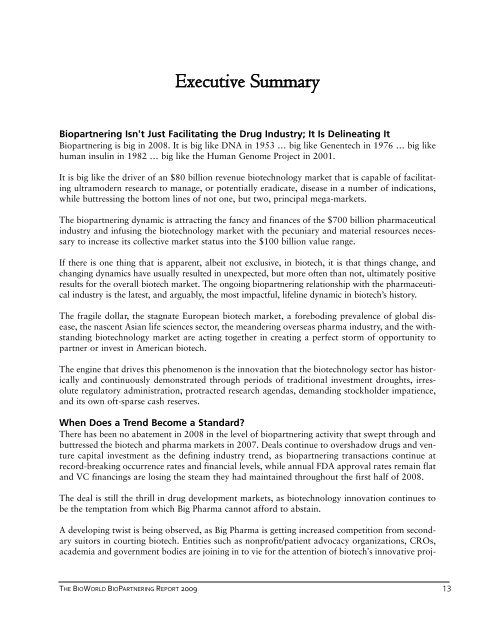BioPartnering Executive Summary - 3.qxd - Medical Device Daily
BioPartnering Executive Summary - 3.qxd - Medical Device Daily
BioPartnering Executive Summary - 3.qxd - Medical Device Daily
You also want an ePaper? Increase the reach of your titles
YUMPU automatically turns print PDFs into web optimized ePapers that Google loves.
<strong>Executive</strong> <strong>Summary</strong><br />
Biopartnering Isn’t Just Facilitating the Drug Industry; It Is Delineating It<br />
Biopartnering is big in 2008. It is big like DNA in 1953 … big like Genentech in 1976 … big like<br />
human insulin in 1982 … big like the Human Genome Project in 2001.<br />
It is big like the driver of an $80 billion revenue biotechnology market that is capable of facilitating<br />
ultramodern research to manage, or potentially eradicate, disease in a number of indications,<br />
while buttressing the bottom lines of not one, but two, principal mega-markets.<br />
The biopartnering dynamic is attracting the fancy and finances of the $700 billion pharmaceutical<br />
industry and infusing the biotechnology market with the pecuniary and material resources necessary<br />
to increase its collective market status into the $100 billion value range.<br />
If there is one thing that is apparent, albeit not exclusive, in biotech, it is that things change, and<br />
changing dynamics have usually resulted in unexpected, but more often than not, ultimately positive<br />
results for the overall biotech market. The ongoing biopartnering relationship with the pharmaceutical<br />
industry is the latest, and arguably, the most impactful, lifeline dynamic in biotech’s history.<br />
The fragile dollar, the stagnate European biotech market, a foreboding prevalence of global disease,<br />
the nascent Asian life sciences sector, the meandering overseas pharma industry, and the withstanding<br />
biotechnology market are acting together in creating a perfect storm of opportunity to<br />
partner or invest in American biotech.<br />
The engine that drives this phenomenon is the innovation that the biotechnology sector has historically<br />
and continuously demonstrated through periods of traditional investment droughts, irresolute<br />
regulatory administration, protracted research agendas, demanding stockholder impatience,<br />
and its own oft-sparse cash reserves.<br />
When Does a Trend Become a Standard?<br />
There has been no abatement in 2008 in the level of biopartnering activity that swept through and<br />
buttressed the biotech and pharma markets in 2007. Deals continue to overshadow drugs and venture<br />
capital investment as the defining industry trend, as biopartnering transactions continue at<br />
record-breaking occurrence rates and financial levels, while annual FDA approval rates remain flat<br />
and VC financings are losing the steam they had maintained throughout the first half of 2008.<br />
The deal is still the thrill in drug development markets, as biotechnology innovation continues to<br />
be the temptation from which Big Pharma cannot afford to abstain.<br />
A developing twist is being observed, as Big Pharma is getting increased competition from secondary<br />
suitors in courting biotech. Entities such as nonprofit/patient advocacy organizations, CROs,<br />
academia and government bodies are joining in to vie for the attention of biotech’s innovative proj-<br />
THE BIOWORLD BIOPARTNERING REPORT 2009<br />
13

















